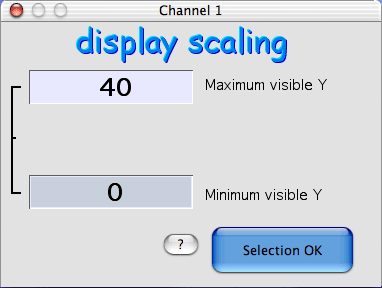 This operation sets the
upper and lower Y-axis limits for the screen display of a particular channel.
The default values are -5 to 5. If you pick one of the pre-defined
voltage conversions, the Y-axis scaling
will be preset automatically. Similarly, if you use the 'Direct
calibration' function, scaling will be based on the range
of values used during the calibration procedure. If you wish to set
a different scaling from the default or the pre-defined values, enter your
choices in the two edit fields before you click the 'Selection OK' button.
This operation sets the
upper and lower Y-axis limits for the screen display of a particular channel.
The default values are -5 to 5. If you pick one of the pre-defined
voltage conversions, the Y-axis scaling
will be preset automatically. Similarly, if you use the 'Direct
calibration' function, scaling will be based on the range
of values used during the calibration procedure. If you wish to set
a different scaling from the default or the pre-defined values, enter your
choices in the two edit fields before you click the 'Selection OK' button.
Note that the scaling you select applies only
to the SCREEN display. Even if values are offscale on the
screen, they will still be recorded correctly in
the data file -- provided they do not exceed the voltage limits
of the A to D hardware.
- As for other parameters, you can set or adjust the scaling limits in
the DISPLAY SETUP window.
Sample Averaging
These menu options let you select the number of voltage readings to be averaged
for each recorded Chart sample value. Averaging is useful for
eliminating background electrical noise, or other short-term variation that
may obscure long-term trends. It may also be used to obtain single
integrated readings from long intersample intervals. Some important
aspects of averaging:
When the default
Continuous, all channels
option is selected (A-D menu; available
in Chart mode only), all channels are scanned sequentially and continually
throughout the sample interval. The Averaging window does not
appear, and differences in the number of averaged readings between channels
are not possible. This mode provides a more continuous sampling of
each channel than in the 'User specified, each channel' mode (A-D menu), wherein each sample is
sampled for a specific number of averages before proceeding to the next channel. It differs
from the 'continuous, last channel' option (A-D menu) in that all
channels are scanned continuously, not just the last one.
| In Continuous, all channels mode, the
number of averaged readings per recorded sample depends on the number of
channels, the sample interval, and the speed of the computer and the A-D
converter. |
NOTE: sample averaging is automatic if you have selected
Oscilloscope plus Chart mode. In this mode a voltage reading is made
from ALL channels when the oscilloscope reading is made. When the
sample interval for chart channels has elapsed, the stored readings for
the chart channels are averaged, plotted, and saved. Thus the number
of samples averaged for chart channels is roughly equal to the value:
chart sample interval / oscilloscope sample
interval
Use of this method simplifies calculations and allows the highest possible
oscilloscope sampling rate.